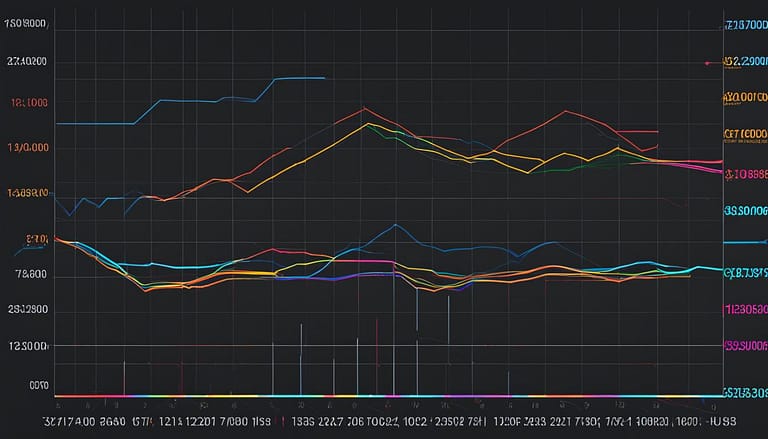The Future of Cryptocurrency Investing: What Lies Ahead
html
Navigating through choppy waters, the cryptocurrency market has entered 2023 with a blend of caution and intrigue from investors across the globe, including Canada. Tensions abound, fueled by inflation, geopolitical undercurrents, and far-reaching macroeconomic shifts, have substantially imprinted their mark on the market’s performance. Yet, despite these challenges, the endurance of the digital currency landscape continues to spark discussions centred on future predictions and investment trends that forecast not only recovery but potential prosperity. 2023 thus poses to unfold the pages of a narrative brimming with potential growth within regulatory environments and an ever-expanding audience for technological financial solutions.
The foresight into the digital currency landscape suggests a midst replete with pivotal regulatory updates, advancing strides towards mass-market adoption and the formulation of novel financial instruments like Bitcoin-centric ETFs. The composition of these elements will likely sculpt the investment terrain in Canada, setting a stage that beckons global attention to the shifts within the cryptocurrency market.
Key Takeaways
- Investor’s approach with careful optimism amidst a fluctuating market dynamic.
- Evolving regulatory measures poised to impact investment landscapes profoundly.
- Mass-market crypto adoption may realign consumer transactional behaviours.
- Development of Bitcoin-based ETFs indicating potential mainstream finance integration.
- Global trends and policies continue to cast significant influence on market valuations.
Reflecting on the Volatility: Cryptocurrency’s Performance Analysis
The terrain of cryptocurrency investment is frequently reshaped by the forces of Cryptocurrency Volatility, with Bitcoin Stability often cited as a barometer for the sector’s health. Ethereum Fluctuations similarly offer a window into the realm’s dynamism, keeping investors vigilant. Understanding the Market Momentum is essential in navigating the peaks and troughs that characterize this space.
2022 served as a stark reminder that after periods of aggressive expansion, cryptocurrencies can be subject to swift and severe corrections. Analysts and experts closely watch the historical trend of surges followed by contractions, aiming to identify patterns within the apparent chaos. The following table captures key metrics that underline the movements of Bitcoin and Ethereum:
| Year | Bitcoin Highest Value (USD) | Bitcoin Lowest Value (USD) | Ethereum Highest Value (USD) | Ethereum Lowest Value (USD) |
|---|---|---|---|---|
| 2020 | 29,000 | 5,000 | 750 | 140 |
| 2021 | 63,000 | 30,000 | 4,800 | 730 |
| 2022 | 48,000 | 16,000 | 3,800 | 950 |
While Bitcoin Stability remains a central concern, the stark disparity between its annual high and low underscores the asset’s inherent volatility. Ethereum’s journey, marked by more extreme Ethereum Fluctuations, likewise reflects the speculative nature of these assets.
“The interplay between bullish runs and market corrections is a staple of the cryptocurrency domain,” states one market analyst. “Investors seeking to capitalize on Cryptocurrency Volatility must brace for potential abrupt swings in either direction.”
An investment strategy that takes into account Market Momentum is hence key for participating profitably in this genre of digital assets. Tactics range from long-term holding, bet on the overall maturation of the crypto-economy, to dynamic trading that leverages volatility for short-term gains.
- Recognize patterns and market signals
- Adjust portfolios in response to key indicators
- Diversify investments to mitigate risks
For the Canadian investor, staying abreast of both local and global market developments is especially pertinent. The cryptocurrency market continues to be an intriguing blend of opportunity and challenge, requiring a nuanced approach to fully harness its potential.
The Future of Cryptocurrency Investing
As we navigate through the complexities of financial evolution, the cryptosphere continues to stand at the forefront of economic conversation. Speculation and factual insights collide, giving rise to a dynamic environment that demands vigilance and adaptability from market participants. Crypto Market Predictions become more sophisticated with each passing year, taking into consideration the intricate dance between innovation, consumer behaviour, and regulatory oversight.
One cannot speak of cryptocurrency’s future without acknowledging the significant role that Cryptocurrency Legal Framework has to play. Compliance and legislation are not merely hurdles but are essential in sculpting a trustworthy and stable market. Investors remain alert as regulatory frameworks within the U.S. and globally evolve—this legislative landscape plays a pivotal role in defining the future of cryptocurrency investments. In an atmosphere rife with regulatory developments, informed decisions are crucial as entities such as the U.S. Treasury and Securities and Exchange Commission (SEC) navigate through the burgeoning pathways of digital finance.
Importance of Regulatory Evolution in Shaping Crypto Investments
The crypto industry is on the brink of a transformation as regulators worldwide are making concerted efforts to establish a comprehensive legal framework. Such an evolution in policy could well dictate the next phase of growth for digital assets. Progress here is not just anticipated, but necessary, for consistency and protection of investors, ensuring they can manoeuvre within a system that is recognised and respected by policymakers and financial stalwarts alike.
The Rise in Mass-market Adoption of Cryptocurrency Payments
A notable shift toward mass-market adoption may very well become the catalyst needed to drive mainstream acceptance of cryptocurrencies such as Bitcoin, Litecoin, and Dogecoin. As consumers and retailers alike become more comfortable and knowledgeable in using digital currencies for everyday transactions, we can expect an expedited push towards not only simplifying regulatory decisions but also refining the underlying blockchain technology, thus enhancing the overall system and user experience.
Prospects for Exchange-Traded Funds (ETFs)
The intersection of traditional finance and digital innovation can be witnessed through the proliferation of Exchange-Traded Funds (ETFs) based on cryptocurrencies like Bitcoin. Such financial instruments represent significant strides in crypto’s integration into mainstream financial markets, suggesting a bright future where digital assets are not just fringe elements but are core components of an investor’s portfolio. This movement not only underscores the potential of digital assets but also reflects the increasing sophistication and maturation of the cryptocurrency market.
Regulation and Compliance: Navigating the Cryptosphere
The financial landscape is undergoing a transformation as Cryptocurrency Regulation occupies a critical threshold, poised to redefine the sector’s operation and scope. Stakeholders within the crypto community are carefully observing the U.S. government’s maneuvers toward establishing a comprehensive Federal Crypto Framework. Such an initiative carries profound implications for the future of digital currencies, aiming to balance innovation with consumer protection.
Significant in this discourse is the SEC Oversight that seeks to address the unique risks associated with digital assets. Regulatory bodies are grappling with creating tailored policies that serve both the dynamic nature of cryptocurrencies and the mandate to safeguard market integrity and investor trust.
With fresh advances in regulation, the crypto market anticipates clarity that may encourage robust participation and expansion. Enhanced regulatory guidance is the cornerstone for this burgeoning asset class’s continuous growth and investor assurance. As such, the industry eyes the following critical areas in regulatory development:
- Definition and Classification: Establishing clear definitions for various types of digital assets to guide regulatory application.
- Consumer Protection: Structuring safeguards to secure consumer interests without stifling innovation.
- Compliance Measures: Outlining necessary compliance protocols for businesses engaging with cryptocurrencies.
- Interagency Coordination: Ensuring uniformity and synergy among various regulatory bodies.
The expectation of a concrete regulatory framework comes with the foresight that such measures will not only reinforce market stability but also provide a fertile ground for legitimate innovation and healthy competition. Engaging key players and fostering dialogue among regulators, experts, and industry stakeholders is essential for crafting a balanced regulatory environment.
| Aspect of Regulation | Current Status | Expected Progression |
|---|---|---|
| Definition and Classification | In Progress: Terminologies under review | Establishment of Formal Definitions |
| Consumer Protection | Nascent: Existing laws applicable | Specific Crypto-Oriented Regulations |
| Compliance Measures | Ad-Hoc: Varied by state and nature of commerce | Standardized National Compliance Protocols |
| Interagency Coordination | Developing: Some collaborative efforts | Unified Regulatory Approach |
The progression of these areas will serve as linchpins to a thriving, secure, and transparent cryptocurrency market within Canada and beyond. Attention now turns to how swiftly and effectively such frameworks can be developed and implemented to keep pace with the rapid evolution of the cryptosphere.
The Integration of Cryptocurrencies in Traditional Markets
As the frontier between digital and traditional finance continues to blur, the Crypto Market Integration process generates a complex tapestry of both potential and predicaments. While some traditional financial players are embracing Digital Currency Payments, others regard the inherent volatility of cryptocurrencies with caution. This dichotomy captures the essence of the fintech evolution, where old and new financial ideologies are colliding to shape a new economic reality.
Challenges and Opportunities with Crypto Integration
The dynamic nature of cryptocurrencies is both alluring for its innovation and intimidating for its unpredictable value shifts. Traditional retailers, accustomed to the relative stability of conventional markets, approach the adoption of digital assets cautiously. Concerns over volatility aside, the burgeoning cryptocurrency sphere could usher in unprecedented regulatory changes. These prospective measures aim to refine and structure the digital revolution in ways that preserve the integrity of financial systems while exploring new economic potentials.
Potential for Cryptocurrencies to Reinvent Money Exchange
At the heart of it all, cryptocurrencies boast the revolutionary potential to overhaul the very foundations of money exchange. Despite this, their path towards mass acceptance is fraught with challenges, not least of which are regulatory hurdles. Policymakers and regulatory entities, seeking to protect markets and consumers, may inadvertently slow or redirect the journey of digital currency innovation. As this narrative unfolds, critical insights into the evolving nature of fiscal exchanges come to light, underscored by the need for responsive and forward-thinking legislation.
| Aspect | Traditional Finance | Cryptocurrency |
|---|---|---|
| Stability | Established, with regulated fluctuations | Subject to high volatility |
| Payments | Fiat-based transactions | Digital currency transactions |
| Regulatory Oversight | Well-defined frameworks | Emerging regulations in development |
| Innovation Potential | Incremental | Exponential |
| Consumer Perception | Widely trusted | Growing trust with increased adoption |
Technological Advancements: The Next Generation of Blockchain
In the rapidly evolving landscape of digital finance, Blockchain Development has catalyzed a transformative shift in how we perceive financial transactions and asset management. Standing at the forefront of this technological revolution are Smart Contract Technology and Crypto Innovations, both of which are extracting numerous inefficiencies from traditional business models and enabling a level of automation and security previously deemed unattainable.
As we observe the integration of blockchain technologies into a myriad of industries, it’s crucial to recognize the significance of smart contracts. These self-executing contractual states, stored on blockchain, cut out intermediaries and ensure transactions are completed only when specific conditions are met. The promise of smart contract technology is not confined to financial sectors only; it extends into legal, real estate, and even into governance, poised to redefine interaction models across these domains.
Innovation table:
| Crypto Innovation | Potential Impact | Current Application |
|---|---|---|
| Smart Contracts | Reduction in the need for intermediaries, increased transaction speed and security. | Decentralized finance (DeFi) platforms, automated legal agreements. |
| Decentralized Autonmous Organizations (DAOs) | Redefinition of organizational management and governance | Community-led venture funding, decentralized governance systems. |
| Non-fungible Tokens (NFTs) | Provision of a unique digital ownership and monetization models for creators. | Art industry, music rights management, digital collectibles. |
| Tokenization of Assets | Division of real-world assets into digital shares, enabling broader investment opportunities. | Real estate, art, intellectual property. |
The blockchain development arena continues to break ground with advancements in ledger technology, enhancing scalability and interoperability among different blockchain systems. This is more than a single leap forward; it’s an ongoing journey of progressive steps, where each stride opens new possibilities for crypto utilities and applications.
Entering a new era of digital asset management and trade, the adherents of crypto innovations are conceptually and practically reshaping the global financial systems. And while these advancements propose a future that some might still consider speculative, they closely align with the ever-growing need for a digitally fluent, secure, and decentralized finance infrastructure.
The implications for business, governance, and personal transactions are profound. By enabling everything from micropayments that could revolutionize content payment structures to secure voting systems that make electoral fraud a relic of the past, the next generation of blockchain could well be the bedrock upon which the future of secure digital interactions is built.
Investor Sentiment and Market Predictions for 2024
The financial community stands on the cusp of a transformative period as the Bitcoin Halving Event nears. With April 2024 marked on calendars, speculation circulates about the potential outcomes and ramifications for the cryptocurrency market. Prior halving mechanisms have catalyzed notable fluctuations in Bitcoin’s price, lending critical importance to this anticipated occurrence.
As investors look ahead to this milestone with baited anticipations, it’s clear that the manifold repercussions of the halving will reverberate across the entirety of the crypto investment landscape. Here are two critical angles framing the discussion:
Evaluating the Market Outlook Ahead of Bitcoin Halving
The anticipated Bitcoin halving in April 2024 could precipitate a substantial market response, harnessing global attention. Past instances have punched through routine market trajectories, provoking rigorous analysis from various financial quarters. This forthcoming event is hypothesized to initiate a similar, if not greater, market response, potentially charting a positive course for Bitcoin’s valuation.
Observers also keep a close eye on developments concerning regulatory approvals, specifically the green-lighting of cryptocurrency ETFs. The interplay between market anticipation of the halving and the SEC’s possible regulatory endorsements could unleash an unprecedented wave of capital influx into the digital asset space, diversifying the asset class transformation already underway.
Developments Paving the Way for Institutional Investment
In terms of Institutional Crypto Investment, the ongoing shifts in market structures testify to an evolutionary phase through 2023. There has been an increased sophistication among advisor investment avenues and infrastructure support that suggests a broadening base for institutional engagement. A significant investment leap from established financial entities is forecasted, implying wider acceptance of digital assets in diversified investment portfolios.
This wave of institutional curiosity signals not just a fad but a recalibration of investment norms, where cryptocurrencies are progressively viewed as a mainstay rather than a high-risk, alternative venture.
| Year | Bitcoin Valuation Pre-Halving | Bitcoin Valuation Post-Halving | Institutional Investment Shifts |
|---|---|---|---|
| 2012 | Steady Growth | Significant Uptick | Minimal Institutional Interest |
| 2016 | Increased Volatility | Sustained Bull Run | Emerging Curiosity |
| 2020 | Strong Valuation | Exponential Surge | Growing Adoption |
| 2024 (Anticipated) | Market Anticipation | Projected Growth | Significant Institutional Entry |
A collective breath is held among market players as these seminal events inch closer. The coming years are poised to validate cryptocurrency’s maturation into an esteemed and dependable asset class. A confluence of regulatory acceptance, market anticipation, and institutional involvement sets the stage for what could be the most pivotal era in digital asset investing thus far.
Crypto Beyond Bitcoin: The Emergence of Alternative Digital Currencies
The vast universe of cryptocurrencies extends significantly past the dominion of Bitcoin and Ethereum. In this expansion, altcoins serve as the vanguards of digital currency diversification and are pivotal to the concept of cryptocurrency asset allocation. Exploring the full breadth of this dynamic market can yield opportunities for investors to mitigate risks while potentially enhancing returns.
As investors aim to construct a resilient and diverse portfolio, it is essential to understand the varying characteristics and market behaviors of different altcoins. The growth and adoption of each altcoin depend on a myriad of factors, including technological advancements, community support, and real-world applications.
| Altcoin | Market Cap | Unique Proposition |
|---|---|---|
| Litecoin (LTC) | $X Billion | Faster transaction times compared to Bitcoin. |
| Ripple (XRP) | $Y Billion | Real-time cross-border payment system. |
| Cardano (ADA) | $Z Billion | Focus on security and sustainability through research-driven approach. |
| Polkadot (DOT) | $A Billion | Facilitates inter-blockchain communication and scalability. |
These altcoins each present unique opportunities and considerations for investment. Litecoin’s speed, Ripple’s payment network, Cardano’s scientific philosophy, and Polkadot’s interoperability are just a few of the aspects that define their presence in the market. Through such varied offerings, altcoins empower investors to steer away from concentration risk associated with heavyweights like Bitcoin.
Diversifying across these and other altcoins, however, should be approached with due diligence and research. Understanding the underlying technology, the team behind a project, and the coin’s road map are essential in making informed investment decisions.
In conclusion, while Bitcoin and Ethereum may have paved the path for cryptocurrencies, altcoins are carving out a landscape rich with opportunity and diversity. For the modern investor, staying abreast of these burgeoning sectors is crucial for informed cryptocurrency asset allocation that aligns with their investment strategy and risk appetite.
The Ripple Effect of Geopolitical Events on Cryptocurrency
Geopolitical tensions and macroeconomic developments present a myriad of challenges and opportunities within the scope of the crypto market. It is these events that often stir considerable Crypto Market Fluctuations, as seen through the lens of historical precedents. Notably, in an increasingly interconnected world, the influence of such events on crypto valuations cannot be overemphasized. We observe a tangible interplay between Government Cryptocurrency Policy and the resilience of the digital currency ecosystem, painting a vivid picture of the Global Economic Impacts at play.
At the heart of this discussion lies the understanding that geopolitical tensions and related macroeconomic shifts serve as both a barometer and a catalyst for crypto valuations. Their capricious nature only serves to amplify the inherent volatility in the cryptocurrency markets.
How Global Crises Influence Crypto Valuations
Significant global crises, from trade wars to the imposition of sanctions, can lead to a knee-jerk reaction within the realms of digital currency. These events impel investors to hedge or reallocate assets, often viewing cryptocurrency as either a safe haven or a risk too great to retain during periods of uncertainty. As such, the market’s response to these crises often becomes a testament to the intricate and sometimes sensitive interactive dynamics between world events and digital currency stability.
Examining the Impact of Government Policies on Cryptocurrency Stability
The fabric of cryptocurrency stability is interwoven with the threads of legislature and executive decisions. Government regulations and policy decisions act as pivotal switches in either propelling forward or hindering the stability and growth of digital currencies. With nations examining the role of cryptocurrency in their economic future, policy shifts can induce significant impacts on valuations and investor reassurance. In essence, each governmental step towards new legislation or the relaxed oversight can create ripples that resonate across the global crypto ecosystem.
Indeed, understanding these dynamics isn’t merely academic but crucial for investors, policymakers, and enthusiasts who navigate the ever-evolving cryptocurrency landscape. The tether between traditional economics and digitally-native currencies solidifies with each passing event, emphasizing the need for close observation and nuanced analysis.
Diversification Strategies for the Modern Crypto Investor
In the dynamic sphere of digital currencies, the savvy investor recognizes the importance of Crypto Portfolio Diversification as a hedge against market volatility. This deliberate approach to Risk Mitigation and strategic Asset Allocation is essential to safeguard investments from the unpredictable swings famously associated with cryptocurrencies.
Here are reasons why diversifying your portfolio across various crypto assets can shield you from unexpected market downturns:
- Reduction of Volatility: Spreading your investment across multiple cryptocurrencies can lessen the impact of a drastic price movement in any single asset.
- Exposure to Various Sectors: Different crypto assets operate within various niche markets and industries, broadening exposure and opportunities.
- Capitalizing on Market Movements: As some cryptocurrencies might underperform, others could see substantial gains, helping to balance your portfolio performance.
Diversity within a crypto portfolio isn’t limited to holding a range of cryptocurrencies. It also involves diversifying across different asset types and considering how each correlates with market behaviors:
Striking the right balance between different types of assets can mean the difference between enduring a downturn and capitulating to one.
When considering Asset Allocation, several categories come into play:
- Mainstream Cryptocurrencies: These are your well-known coins like Bitcoin and Ethereum which are regarded as more ‘stable’ investments in the crypto world.
- Altcoins and Tokens: This category includes a plethora of coins that serve various purposes and have varying degrees of risk and potential reward.
- Stablecoins: Tied to a reserve asset like the US dollar, stablecoins can offer a haven during market turbulences.
- DeFi and NFTs: For those looking to venture into the newest sectors of blockchain technology, these investments bear consideration.
The following table illustrates an exemplary approach to Crypto Portfolio Diversification with hypothetical asset allocation percentages:
| Asset Type | Recommended Allocation (%) | Volatility Level | Potential for Long-Term Growth |
|---|---|---|---|
| Mainstream Cryptocurrencies | 40 | Medium | High |
| Altcoins and Tokens | 25 | High | Medium to High |
| Stablecoins | 20 | Low | Low |
| DeFi and NFTs | 15 | High | Varies |
It’s imperative to remember that diversification is not a one-size-fits-all solution; it must be tailored to each investor’s risk tolerance, investment goals, and market outlook. Regular portfolio reviews and adjustments are also crucial as market conditions evolve.
In conclusion, a well-diversified crypto portfolio serves as the bedrock of a resilient investment strategy in a fluctuating market. When done right, it’s nothing short of vital for the modern crypto investor’s journey towards financial success.
Conclusion
As we encapsulate our exploration of the Future of Cryptocurrency, it is evident that the sector has navigated turbulent waters and emerged with lessons that could enhance its resilience. With careful consideration of Long-term Market Outlook, investors and market spectators alike recognize that the path forward for this digital currency landscape is not linear. However, by taking a holistic view of the industry and considering diverse aspects such as technology, regulatory developments, and market dynamics, we can discern a pattern for future growth.
The Long-term Outlook and Sustainability of Cryptocurrency Investments
When it comes to the sustainability and robustness of cryptocurrency investments, adaptability emerges as a crucial determinant. The industry’s ability to absorb regulatory shifts, global economic tremors, and innovative breakthroughs is not just commendable—it’s foundational for the industry’s long-term success. A prudent investor should remain vigilant, as the efficacy of their investment hinges on a landscape consistently shaped by an array of legislative and economic factors.
In conclusion, the endurance of cryptocurrencies as a facet of modern investment is interwoven with the efficiency and responsiveness of its infrastructure. With a steadfast eye on sustainable crypto investments, stakeholders must foster an environment where growth is not only envisioned but actively cultivated through strategic adaptation and alignment with global trends. Thus, the future shines with possibility for those embracing change within this digital asset domain.










